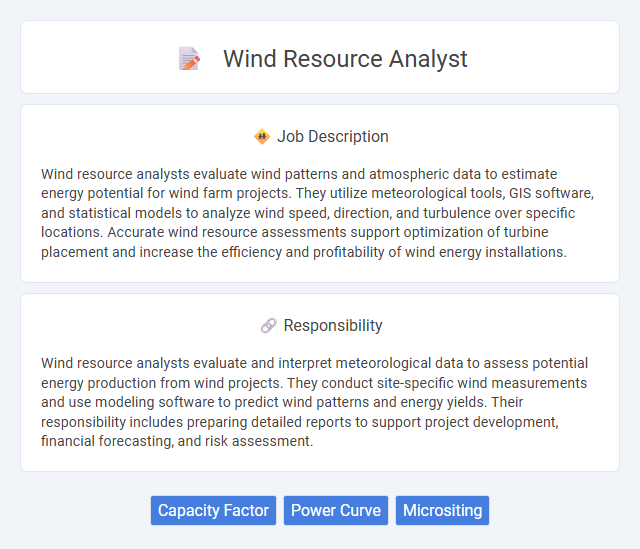
Wind resource analysts evaluate wind patterns and atmospheric data to estimate energy potential for wind farm projects. They utilize meteorological tools, GIS software, and statistical models to analyze wind speed, direction, and turbulence over specific locations. Accurate wind resource assessments support optimization of turbine placement and increase the efficiency and profitability of wind energy installations.
Individuals with strong analytical skills and a passion for renewable energy are likely well-suited for a Wind Resource Analyst position. Those comfortable working with data, geographic information systems (GIS), and meteorological software may find this role both engaging and rewarding. People who prefer solitary work or minimal field activity might face challenges, as the job often involves collaboration and site visits.
Qualification
A Wind Resource Analyst requires a strong background in meteorology, environmental science, or engineering, often holding a bachelor's or master's degree in these fields. Proficiency in data analysis tools such as MATLAB, Python, and GIS software is essential to process and interpret wind data accurately. Experience with wind measurement equipment, statistical modeling, and knowledge of the wind energy industry standards enhance the candidate's ability to assess site viability and optimize turbine placement.
Responsibility
Wind resource analysts evaluate and interpret meteorological data to assess potential energy production from wind projects. They conduct site-specific wind measurements and use modeling software to predict wind patterns and energy yields. Their responsibility includes preparing detailed reports to support project development, financial forecasting, and risk assessment.
Benefit
A Wind Resource Analyst likely provides significant benefits by accurately assessing wind patterns to optimize turbine placement and energy production. This role may enhance project feasibility, reduce financial risks, and contribute to efficient renewable energy development. Strong data analysis skills and understanding of meteorological models could increase overall project success and sustainability.
Challenge
The role of a wind resource analyst likely involves interpreting complex meteorological data, which can be challenging due to the variability and unpredictability of wind patterns. Accurate forecasting and modeling might require advanced technical skills and continuous adaptation to new technologies and methodologies. Balancing the need for precise analysis with project deadlines could frequently present significant professional challenges.
Career Advancement
Wind resource analysts play a critical role in assessing and optimizing wind energy projects through data modeling and meteorological analysis. Mastery of advanced software tools such as WindPro, WAsP, and GIS enhances job performance and opens pathways to senior analyst or project management positions. Gaining certifications in renewable energy and staying current with industry regulations significantly boosts opportunities for career growth within leading energy companies.
Key Terms
Capacity Factor
Wind resource analysts evaluate wind patterns to estimate the Capacity Factor, a key metric reflecting the actual energy output of a wind turbine relative to its maximum potential. Accurate Capacity Factor assessments influence project feasibility, financial modeling, and optimization of turbine placement. Proficiency in meteorological data analysis, simulation software, and site-specific environmental factors is essential for maximizing wind farm efficiency and return on investment.
Power Curve
A Wind Resource Analyst specializing in Power Curve evaluation plays a critical role in assessing turbine performance by analyzing data on wind speed and energy output. They utilize power curve modeling to predict energy production accurately and optimize turbine efficiency, ensuring alignment with manufacturer specifications under variable wind conditions. Expertise in statistical analysis and meteorological data interpretation supports reliable forecasting and financial viability assessments in wind energy projects.
Micrositing
Wind resource analysts specializing in micrositing use detailed meteorological data and advanced modeling software to identify optimal turbine locations within a wind farm. They analyze terrain, wind patterns, and wake effects to maximize energy production and minimize environmental impact. Precise micrositing improves project efficiency, reduces costs, and enhances overall wind farm performance.
 kuljobs.com
kuljobs.com